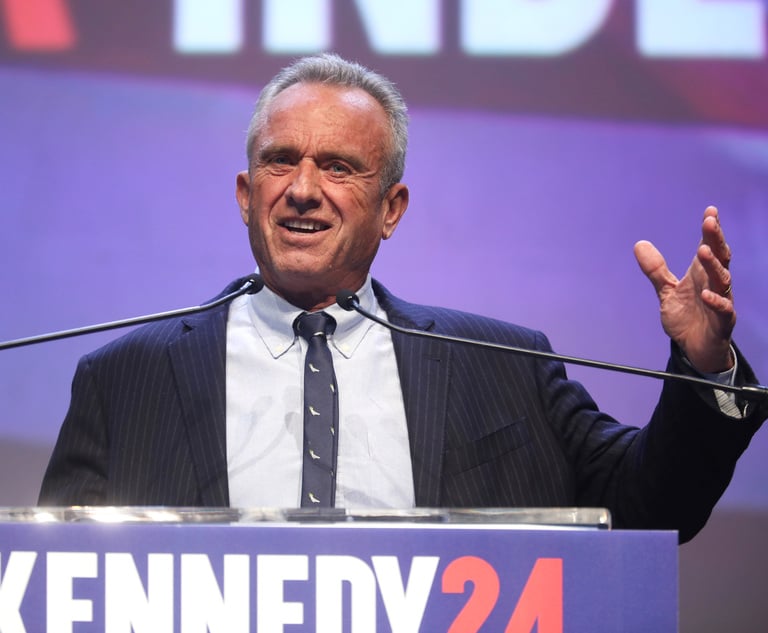Corporate America Embraces Short-Term IOUs as Free Money Ends
The total amount of these IOUs outstanding has mushroomed to nearly $1.2 trillion this year, up more than 20% from its lows in 2020, with computing giant Apple Inc. and pipeline-owner Kinder Morgan Inc. among those that have been dipping more into the market.
July 27, 2022 at 10:26 AM
6 minute read
Blue-chip companies that need to borrow in the US now are increasingly relying on commercial paper to avoid locking in longer-term borrowing costs in a market beset by turbulence.
With the Federal Reserve poised for a fresh hike Wednesday, the days when blue-chip firms borrow super cheaply for decades are gone, at least for now. Corporate treasurers have instead been turning more to commercial paper, a type of unsecured debt that typically lasts 270 days or less.
The total amount of these IOUs outstanding has mushroomed to nearly $1.2 trillion this year, up more than 20% from its lows in 2020, with computing giant Apple Inc. and pipeline-owner Kinder Morgan Inc. among those that have been dipping more into the market this year. At the same time, investment-grade companies are relying less on longer-term debt markets, with sales of high-grade corporate bonds dropping about 7% in 2022, according to data compiled by Bloomberg.
If you strip out banks and other financial companies, sales of this kind of debt in the first half of this year were the lowest since at least 2016, according to BMO Capital Markets. Companies are essentially betting that the Fed will get inflation under control, and that longer-term rates will stabilize after rising for much of the year.
"All this volatility has corporations just trying to ride this out with commercial paper issuance as more of a placeholder for them until things start to calm down," said Peter Yi, director of short-duration fixed income and head of credit research at Northern Trust Asset Management, which oversees around $1.2 trillion.
In re-embracing commercial paper, companies are returning to a market that has a history of seizing up during systemic crises. But lately borrowing in longer-term markets has grown trickier than it usually is.
There have been about 49 days in 2022 where not a single company sold corporate bonds, which can imply that the market was essentially closed, compared with 12 days in the same period last year, according to data compiled by Bloomberg News. An index of bond market volatility, the ICE BofA MOVE Index, had climbed to 128.27 as of Monday, from 77.1 at the end of last year.
The Fed is in tightening mode — officials are widely expected to lift the central bank's benchmark by 0.75 percentage point at its next decision Wednesday so rates at the very shortest parts of the lending curve aren't likely to retreat much any time soon. The longer-term outlook is harder to forecast, especially if rate hikes end up pushing the economy into a slump.
There are already early signs of potential recession, including an inversion of key segments of the Treasury yield curve and news this week from big-box retailer Walmart Inc. that shoppers are cutting back. That kind of macroeconomic uncertainty has made many investors reluctant to buy longer-term corporate bonds from those companies that have been willing to venture into the market.
Meanwhile, heightened investor demand for commercial paper has made it relatively cheap for companies to fund in that market. For example, borrowing for 30 days in the commercial paper market can cost about 2.25% as of Monday, while yields on high-grade bonds maturing in one to three years were averaging about 3.95%. The gap between those two rates — a measure of the savings from borrowing in the CP market — is wide compared with the averages for the last five years.
"I think supply has followed demand here, and it's a reflection of the large gap in terms of pricing in commercial paper rates versus the front-end bond market," said JPMorgan Chase & Co. strategist Nathaniel Rosenbaum.
Coming Back
Banks have been significant sellers of commercial paper for years, but the biggest shift recently has been among companies outside the financial sector, said Erin Gonzalez, head of commercial paper trading at Barclays Plc. Commercial paper outstanding bottomed out around $945 billion in September 2020 before rebounding, Fed data show. The amount of total outstanding is $1.17 trillion as of July 20, though that's still only about half the size of its peak in 2007.
"We're seeing corporations come back," Gonzalez said. "Corporate issuers that termed out during the crisis are returning."
Even as companies increasingly borrow in the commercial paper market, some money managers remain wary of it. During the March 2020 turmoil, panicked investors yanked billions from money funds in a matter of weeks, contributing to the seizing up of the commercial-paper market. Companies had to pay off their maturing IOUs with either precious cash or money from a bank line.
That required the Federal Reserve to provide emergency support to ensure markets, and even money-market funds, would continue to function. The Fed had to similarly support the commercial paper market after Lehman Brothers failed.
"The experience we have witnessed over the past two decades with regard to commercial paper — which not only had massive re-pricings but also elicited formal responses from the Fed — is still relatively fresh in our minds," said Jerome Schneider, head of short-term portfolio management and funding at Pacific Investment Management Co., one of the largest bond fund managers in the world.
Regulatory changes in the US money market industry have sapped demand for commercial paper for years, and more changes are coming that could reduce the funds' purchases even more. Prime money market funds are buying about $480 billion of the short-term IOUs annually versus $725 billion in 2019, John Kodweis, head of commercial paper origination at JPMorgan, said at a conference last month.
Money Markets Rake In Cash as Funds Gird for Regulatory Changes
Despite any misgivings about prior turmoil and potential regulatory changes, short-end investors have large piles of cash and are looking for places to invest it. And many companies take comfort knowing the Fed is inclined to keep the market operating if it seizes up, said Barclays's Gonzalez.
"Issuers that were gone for some time probably would've felt comfortable coming back by the end of 2020," she said. "Going forward, they're not as worried, knowing the Fed stepped in and did what they did."
–With assistance from Michael Gambale.
NOT FOR REPRINT
© 2025 ALM Global, LLC, All Rights Reserved. Request academic re-use from www.copyright.com. All other uses, submit a request to [email protected]. For more information visit Asset & Logo Licensing.
You Might Like
View All
RFK Jr. Will Keep Affiliations With Morgan & Morgan, Other Law Firms If Confirmed to DHHS
3 minute read
Greenberg Traurig Combines Digital Infrastructure and Real Estate Groups, Anticipating Uptick in Demand
4 minute read
US Judge Cannon Blocks DOJ From Releasing Final Report in Trump Documents Probe
3 minute read
As Unpredictability Rises, Gov't Law Practices Expect Trump Bump. Especially in Florida
5 minute readLaw Firms Mentioned
Trending Stories
Who Got The Work
J. Brugh Lower of Gibbons has entered an appearance for industrial equipment supplier Devco Corporation in a pending trademark infringement lawsuit. The suit, accusing the defendant of selling knock-off Graco products, was filed Dec. 18 in New Jersey District Court by Rivkin Radler on behalf of Graco Inc. and Graco Minnesota. The case, assigned to U.S. District Judge Zahid N. Quraishi, is 3:24-cv-11294, Graco Inc. et al v. Devco Corporation.
Who Got The Work
Rebecca Maller-Stein and Kent A. Yalowitz of Arnold & Porter Kaye Scholer have entered their appearances for Hanaco Venture Capital and its executives, Lior Prosor and David Frankel, in a pending securities lawsuit. The action, filed on Dec. 24 in New York Southern District Court by Zell, Aron & Co. on behalf of Goldeneye Advisors, accuses the defendants of negligently and fraudulently managing the plaintiff's $1 million investment. The case, assigned to U.S. District Judge Vernon S. Broderick, is 1:24-cv-09918, Goldeneye Advisors, LLC v. Hanaco Venture Capital, Ltd. et al.
Who Got The Work
Attorneys from A&O Shearman has stepped in as defense counsel for Toronto-Dominion Bank and other defendants in a pending securities class action. The suit, filed Dec. 11 in New York Southern District Court by Bleichmar Fonti & Auld, accuses the defendants of concealing the bank's 'pervasive' deficiencies in regards to its compliance with the Bank Secrecy Act and the quality of its anti-money laundering controls. The case, assigned to U.S. District Judge Arun Subramanian, is 1:24-cv-09445, Gonzalez v. The Toronto-Dominion Bank et al.
Who Got The Work
Crown Castle International, a Pennsylvania company providing shared communications infrastructure, has turned to Luke D. Wolf of Gordon Rees Scully Mansukhani to fend off a pending breach-of-contract lawsuit. The court action, filed Nov. 25 in Michigan Eastern District Court by Hooper Hathaway PC on behalf of The Town Residences LLC, accuses Crown Castle of failing to transfer approximately $30,000 in utility payments from T-Mobile in breach of a roof-top lease and assignment agreement. The case, assigned to U.S. District Judge Susan K. Declercq, is 2:24-cv-13131, The Town Residences LLC v. T-Mobile US, Inc. et al.
Who Got The Work
Wilfred P. Coronato and Daniel M. Schwartz of McCarter & English have stepped in as defense counsel to Electrolux Home Products Inc. in a pending product liability lawsuit. The court action, filed Nov. 26 in New York Eastern District Court by Poulos Lopiccolo PC and Nagel Rice LLP on behalf of David Stern, alleges that the defendant's refrigerators’ drawers and shelving repeatedly break and fall apart within months after purchase. The case, assigned to U.S. District Judge Joan M. Azrack, is 2:24-cv-08204, Stern v. Electrolux Home Products, Inc.
Featured Firms
Law Offices of Gary Martin Hays & Associates, P.C.
(470) 294-1674
Law Offices of Mark E. Salomone
(857) 444-6468
Smith & Hassler
(713) 739-1250






